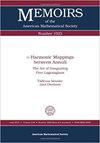递增一元的表示理论
IF 2
4区 数学
Q1 MATHEMATICS
引用次数: 13
摘要
研究了递增单群的表示理论。我们的结果提供了一个相当全面的表示范畴的图像:例如,我们描述了Grothendieck群(包括有效锥),对射射对象进行了分类,建立了射射分辨率和射影分辨率的性质,构造了派生的自对偶性,等等。我们的工作是由该理论与其他领域的许多联系所驱动的,例如表示稳定性、交换代数、简单理论和洗牌代数。本文章由计算机程序翻译,如有差异,请以英文原文为准。
The Representation Theory of the Increasing Monoid
We study the representation theory of the increasing monoid. Our results provide a fairly comprehensive picture of the representation category: for example, we describe the Grothendieck group (including the effective cone), classify injective objects, establish properties of injective and projective resolutions, construct a derived auto-duality, and so on. Our work is motivated by numerous connections of this theory to other areas, such as representation stability, commutative algebra, simplicial theory, and shuffle algebras.
求助全文
通过发布文献求助,成功后即可免费获取论文全文。
去求助
来源期刊
CiteScore
3.50
自引率
5.30%
发文量
39
审稿时长
>12 weeks
期刊介绍:
Memoirs of the American Mathematical Society is devoted to the publication of research in all areas of pure and applied mathematics. The Memoirs is designed particularly to publish long papers or groups of cognate papers in book form, and is under the supervision of the Editorial Committee of the AMS journal Transactions of the AMS. To be accepted by the editorial board, manuscripts must be correct, new, and significant. Further, they must be well written and of interest to a substantial number of mathematicians.

 求助内容:
求助内容: 应助结果提醒方式:
应助结果提醒方式:


